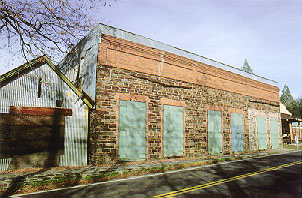 Gold Country |  Malakoff Home |

 The Gamble Block, as it was known during the 1850ís and 1860ís, is one of the finest and
largest stone store buildings remaining in the Gold Country. Completed in 1852, the structure was
built for Alexander Gamble, a very successful Gold Rush merchant. Constructed in a similar
fashion to the Odd Fellows Hall, of stone, lime mortar, and brick, this large building actually
housed three separate stores within. Behind each of the six large iron doors are conventional
wooden doors with glass panels. During the day the iron doors would be opened and fastened
against the walls, allowing the storeís customers to enter and exit through the inner doors. At
night, everything would be locked tight against fire and theft.
The Gamble Block, as it was known during the 1850ís and 1860ís, is one of the finest and
largest stone store buildings remaining in the Gold Country. Completed in 1852, the structure was
built for Alexander Gamble, a very successful Gold Rush merchant. Constructed in a similar
fashion to the Odd Fellows Hall, of stone, lime mortar, and brick, this large building actually
housed three separate stores within. Behind each of the six large iron doors are conventional
wooden doors with glass panels. During the day the iron doors would be opened and fastened
against the walls, allowing the storeís customers to enter and exit through the inner doors. At
night, everything would be locked tight against fire and theft. Inside the building, a stone wall divides the middle lengthwise and two other partitions
divide the space in thirds. The result is three separate stores facing the street, each with a
rear room for storage or office space. The building originally had a wooden roof over the porch,
which burned; then a corrugated iron roof, which blew off in a windstorm; the porch now gets by with the sky.
Inside the building, a stone wall divides the middle lengthwise and two other partitions
divide the space in thirds. The result is three separate stores facing the street, each with a
rear room for storage or office space. The building originally had a wooden roof over the porch,
which burned; then a corrugated iron roof, which blew off in a windstorm; the porch now gets by with the sky. The store on the west was first used as a general merchandise store by J. D. Murphy and Luigi
Marconi. Joseph Raggio later did quite well selling choice foodstuffs and fancy liquors to miners
lucky enough to afford them. The middle store was occupied over the years by Dominic Cuneo, a man
named Noziglia who ran a store of some sort, a Mr. Cody, and a Colonel Roote who operated a drug
store. The eastern most store housed the Wells Fargo & Co. Express Office from the 1850ís until
1893 when it closed its office. Many other businesses have occupied these stores over the years,
including a tinsmith, a cobbler shop, a grocery store, several saloons, and the post office which
operated during the late 1860ís with William Urich as postmaster.
The store on the west was first used as a general merchandise store by J. D. Murphy and Luigi
Marconi. Joseph Raggio later did quite well selling choice foodstuffs and fancy liquors to miners
lucky enough to afford them. The middle store was occupied over the years by Dominic Cuneo, a man
named Noziglia who ran a store of some sort, a Mr. Cody, and a Colonel Roote who operated a drug
store. The eastern most store housed the Wells Fargo & Co. Express Office from the 1850ís until
1893 when it closed its office. Many other businesses have occupied these stores over the years,
including a tinsmith, a cobbler shop, a grocery store, several saloons, and the post office which
operated during the late 1860ís with William Urich as postmaster.
 Gold Country |  Malakoff Home |